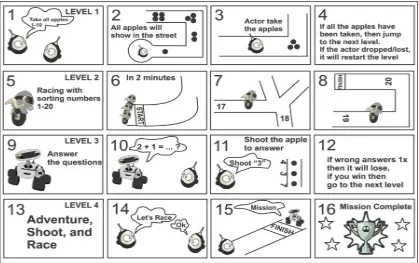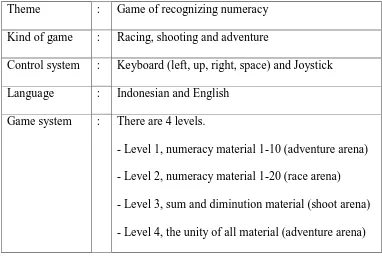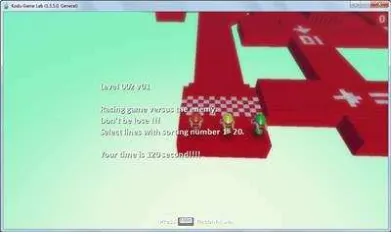EMPOWERING KODU GAME
AS A NUMERACY LEARNING MEDIA
FOR KINDERGARTEN
PUBLICATION ARTICLE
By:
Septiawan Bagus Prambudi
Endah Sudarmilah, S.T, M.Eng
Yusuf Sulistyo Nugroho, S.T, M.Eng
DEPARTMENT OF INFORMATICS
FACULTY OF COMMUNICATIONS AND INFORMATICS
UNIVERSITAS MUHAMMADIYAH SURAKARTA
EMPOWERING KODU GAME AS A NUMERACY LEARNING MEDIA
FOR KINDERGARTEN
Septiawan Bagus Prambudi, Endah Sudarmilah, Yusuf Sulistyo Nugroho
Department of Informatics, Faculty of Communications and Informatics, Universitas Muhammadiyah Surakarta
Email: [email protected]
ABSTRACT
In a process of learning, arithmetic or psychology evaluation, the kindergarten grade
needs some pleasant thing. One of the media that can be used is a game. Game based on
Indonesian-English dictionary means “permainan”. The research purposed to create a game
that can be used to arithmetic measurement. The problem that discussed in this research is
how to create and design a game that has element of educating, attracting and easy to play
and then be able to be the numeracy media for kindergarten. The method used in this game is
System Development Life Cycles method. This method describe the life cycles of system
development in creating and designing game. The result of this creating is the application of
kodu game as a numeracy learning media for Kindergarten that consists of the material about children’s numeracy suitable with the children’s curriculum of Kindergarten in grade B. This game consists of four levels with the different background arena (race, shoot and adventure).
Key Word: game, kodu, numeracy, kindergarten
INTRODUCTION
Education is a process of self-development both as individual and social. The Indonesian’ Act number 20 in 2003
about National Education System Section 28 states that early childhood education can be accomplished through formal,
non-formal, and informal. Kindergarten is early childhood education in the formal education programs for children aged four to six years (Mansur, 2007). Many ways to implement education, but in educating the children don’t forget about the aspect of playing,
Playing is an approach in learning for Kindergarten. Playing is something that fun and exciting (Mussen, 1988). Playing for children not just only plays something, but it is one part of the learning process. When children are playing, they can get the stimulus beside it can make they are very enjoy for more knowledge (Prasetyo, 2007). Preparing learning activities should be done in a pleasant situation and easily followed by the children. One of the ways is by using the media of Game. Game has the basic meaning of having fun playing. Game is defined as a structured activity or be used as a learning tool (Nalwan, 1998). Understanding Game here is a game that played on a computer.
Based on the description above, the researcher has an idea for researching entitled “EMPOWERING KODU GAME
AS A NUMERACY LEARNING MEDIA FOR KINDERGARTEN”. Then through this game it can help the teachers deliver innovation in providing math lessons and
can be measured about the material of count that has been taught.
This research has been done for create a game which there are materials that can be used to assist the children in learning how to do the numeracy with some interesting background arena. This game is also increasing children’s interest in
learning and practice memory skills. Kodu as the main character in this game will do a mission with every different background arena that describe as racing, shooting and adventure. That is would keep the children’s interest and do not tired easily
when seeing this game appearance.
REVIEW OF LITERATURE
that can be used in helping children to learn numeracy, to recognize kind of fruits and vegetables, to know kind of animals and to learn about painting. The methods that could be used are documentation and questioner method. From the sampling of ten people could be concluded that this game was acceptable as media to learn about fruits, vegetables, colors and numeracy (Rafidah, 2012), development. Cognitive competence is related to the children thinking competence. The purpose of the research tends to improve cognitive competence in recognizing enumeration through playing pictorial number card. The method is learning while playing. Cognitive competence divides into 4 cycles. They are pre-cycle (observation), cycle (learning) I, II and III. The result proves that every cycle
realizes more improvement than the cycle before. It proves that method of playing pictorial number card can improve cognitive competence in recognizing enumeration (Rohmah, 2012).
In the other hand, said that recognizing Arabic letters on kindergarten is very important. Arabic letters is the basic knowledge to read Al-Qur’an as way of life of Muslims. Recognizing Arabic letters for children requires effective and enjoyable learning method. This playing media helps recognizing Arabic letters and words. Besides, it will create enjoyable circumstance in learning process through this game. The existing method is documentation and questioner method. Scoring was counted based on questioner result to the teacher of the class of the first grade who agreed with this game. This education game helped recognizing Arabic words on children’s school age. By using
result of the research proves that game success in applying as interactive learning media to recognize Arabic letter (Murniningsih, 2012).
RESEARCH METHOD
a. SDLC (System Development Life Cycle)
SDLC is a method of information system development. It is popular when information system expanded in the first time. SDLC method is formed by steps that worked by information system analyzer and programmer in developing information system.
Figure 1 Flowchart SDLC
There are steps of SDLC method: 1. The step of requirement definition is
a planning process of recognizing and learning application requirement and user potency. It also provides verification of the problem that take place before recognizing and learning application built. So, it can be done a scoring on the new requirement.
2. The analyzing of requirement is a process of searching and analyzing user requirement. It requires information and instrument that used. The other process is balancing application with user requirement. The last is provides the best alternative of application that used by user to facilitate user’s
performance.
3. The step of planning or designing is a planning of user interface design. It consists of appearances, form, and design of “The Application of Kodu
Media for Kindergarten Children”
which contain of arithmetic material for Kindergarten children in grade B.
4. The step of building system is a process of implementation from planning process. It is worked by programmer. After planning is finished, this game can be created by using Kodu Game Labv1.3.5.0 5. Testing the system is the process of
trying out to the learning media application before the application can be used fully. All of the application functions have to be tried out. So, the system is free from error and the result is suitable on user requirement.
6. It is the step of learning media applications maintain. It is occurred software modification, error repairing and user’s feedback to
application that had been used. Maintain application is required. It contain of application development
by completing new features to get the best result.
b. Designing
1. Planning of the System
The planning of the system describes as follows:
a) The purpose of created the system based on the user candidate is learning media and evaluation of numeracy for Kindergarten in grade B.
b) The software Kodu Game Lab v1.3.5.0 gives possibilities to create a game that consists of several levels. The game provides many areas and genres. Likes: if we win the first level, we will continue to the next, next and next level. The Software of Kodu Game Lab
v1.3.5.0 is possible to show description in the beginning of game. The description contains of explanation, game’s
must be done. This game can be worked by using keyboard media controller on computer and joystick.
c) The concept system model that will be created in a game contains of race arena, shoot arena and adventure arena. There are different challenges in every level. Every challenge
provides educative value and relates to numeracy learning. d) The appearance - 3D animation
will serve for purposed to attract children’s interest.
Besides, the appearance shows numeracy element of the game. e) There are directions to play the
game correctly.
f) The system building of storyboard Figure 2 as follows:
Table 1 Storyboard
Theme : Game of recognizing numeracy Kind of game : Racing, shooting and adventure
Control system : Keyboard (left, up, right, space) and Joystick Language : Indonesian and English
Game system : There are 4 levels.
- Level 1, numeracy material 1-10 (adventure arena) - Level 2, numeracy material 1-20 (race arena) - Level 3, sum and diminution material (shoot arena) - Level 4, the unity of all material (adventure arena)
2. Conceptual Planning Specification The researcher created a program of game formation. The theme is recognizing numeracy and the type is racing, shooting and adventuring. This step of educational Kodu game is started from level 1 (adventure arena). The children have to find apple which has different colors in order. The order represent of number 1 up to 10. The children will win the game if they pass the order successfully.
Level 2 (race arena) gives 2 minutes to pass the level. Kodu as main player has to win the race. Then, Kodu follows the way in order 1 up to 20, so that it does not get lost. The player can continue to level 3 if win successfully no more than 2 minutes.
level gives 5 minutes and 5 combination of the previous area. It also contains of racing challenge proper the creating system, whether the system is suitable with the main purpose of the creating. The way to prove it is through questioner with Likert Scale, the formula is:
The highest score/ ideal score (SMax): 5 x n = 5n (SS) ... (1) The lowest score (SMin): 1 x n = n (STS), n = total respondent ... (2)
Score (S): ∑ (total respondent that choosing answer x answer weigh).... (3) Interpretation Percentage (P): Score (S)
x100%
SMax ………(4)
Kindergarten”. The results of the study are
as follow: 1. Level 1
The Kodu game is started from level 1. There is adventure arena that shows on Figure 3. In the beginning of the game, it will appear the mission that must be done. Kodu is the main character of character that played. Adventure is the arena of level 1 where Kodu will walk to the park to finish the mission. In this level, Kodu has to find apple with different colors orderly. It represents number 1-10. Kodu is win if it success to run the number. Then, Kodu can continue to the next level. Kodu is not the only character in this area. There are animal characters in the lake and animal robot that have to go around the area. They remain Kodu to take care. So, Kodu does not fall down.
Figure 3 Arena of Level 1 2. Level 2
Race area is the area in level 2 that shows on Figure 4. This level provides 2 minutes to play. Kodu as the main character has to win. Character Kodu in level 2 is different than level 1 because Kodu looks driving motorcycle in this level. In this level, Kodu has to win the race by following way that contains number 1-20. There are many branches way in level 2. Kodu is possible to get lost. Kodu need to pay attention and sort the number in order, from the smallest to the biggest or 1-20.
3. Level 3
There is a shoot area in level 3 that shows on Figure 5. Kodu has to answer the question. The answer already exists. The player shoots the right answers just like on the description in the beginning of game. The player has 3 opportunities to be wrong. The player of this level is Kodu and animal robot. Animal robot will give questions and Kodu has to answer the arithmetic question. Kodu can continue to the next level if it can clear this level. Being wrong more than twice, it meant game over.
Figure 5 Arena of Level 3 4. Level 4
There is an adventure area in level 3 that shows on Figure 6. In this level, the player has to collect 5 red
apples and 7 yellow coins based on description. Level 4 is quite difficult because the mission has to done by 3 ways; racing, shooting and adventuring. Firstly, Kodu has racing against rival. In the finish line, Kodu will meet animal robot who gives the main mission. If Kodu clear the mission, it wins this game. If Kodu miss the asked object, the game will show black score. Black score is meant wrong. Doing mistake more than three times is game over.
Figure 6 Arena of Level 4
used questioner method for teacher and student. Based on that result testing, could be collected the data as follow:
Figure 7 Percentages in Positive Scoring of Teacher Respondent Group
Figure 8 Percentages in Positive Scoring of Children Respondent Group
The score that collected from every respondent would be guidance to evaluate this system; whether the system worked well or not. Besides, it was also determined whether the creating system was suitable to the main purpose of the system creating.
CONCLUSION
The research conclusion of the application of Kodu game as learning media of numeracy for kindergarten has been completed and has been carried out test in the Islamic Kindergarten Makarima Kartasura by taking sample students of kindergarten level B. From the result of testing, the conclusions as follow:
1. This game has educational characteristic, this is evidenced in the results of the research which states 80% of teacher respondents agreed that this games help the children learn to count.
the results of the research that teachers said they had agreed with this statement are 80% and the children respondent state this game look attractive is 72%. 3. This educational game is easy to play; it
is evident from the result of the research that has been tested on 10 children samples of kindergarten level B who stated percentage of 70%.
Based on description above, it can be concluded that the goal of designed a game that has elements of educational, attracting and easy to play and be able to be the learning media of numeracy for early childhood has been successfully achieved.
Based on description above, it can
be concluded that the goal of designed a
game that has elements of educational,
attracting and easy to play and be able to be
the learning media of numeracy for early
BIBLIOGRAPHY
Depdiknas. 2003. UU Nomor 20 tahun 2003 tentang SISDIKNAS, Jakarta.
M Echols, John and Shadily, Hasan. 2010. Kamus Indonesia Inggris. Jakarta: Gramedia. Mansur, Mansur. 2007. Pendidikan Anak Usia Dini Dalam Islam. Jogjakarta: Pustaka
Pelajar.
Murniningsih, Murniningsih. 2012. Media Bermain Interaktif Huruf Hijaiyah Berbasis Macromedia Flash 8. Skripsi. Surakarta: Fakultas Komunikasi dan Informatika Jurusan Teknik Informatika. Universitas Muhammadiyah Surakarta.
Mussen, Paul Henry.1988. Perkembangan dan Kepribadian Anak. Jakarta: Erlangga. Nalwan, Agustinus. 1998. Pemrograman Animasi dan Game Profesional 4. Jakarta: PT
Elex Media Komputindo.
Prasetyo, Dwi S. 2007. Membedah Psikologi Bermain Anak. Yogyakarta: Think.
Rafidah ,Ismi Aiman. 2012. Perancangan Game Edukatif Bertema Farming Dengan Tokoh Strawberry Shortcake. Skripsi. Surakarta: Fakultas Komunikasi dan Informatika Jurusan Teknik Informatika. Universitas Muhammadiyah Surakarta. Riduwan, and Akdon. 2007. Rumus dan Data dalam Analisis Statistika. Bandung:
Alfabeta.





